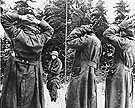
|
|
|

|

|

|

|
|
Click on an image to see a larger, more detailed picture.
|
|
|
|
|
| 1945: Liberation and Rebuilding |

|
pg. 582 |

|
|
|
|
| |
 An American GI stands guard over Germans captured in the Ardennes offensive. Although the German counteroffensive, led by eight panzer divisions, caught the Allies by surprise and scored some initial success, it came to a rapid halt under improved weather and combined pressure from British and American forces. By January 1945 the Germans began their retreat into the Reich, bringing any hope of victory to an end.
An American GI stands guard over Germans captured in the Ardennes offensive. Although the German counteroffensive, led by eight panzer divisions, caught the Allies by surprise and scored some initial success, it came to a rapid halt under improved weather and combined pressure from British and American forces. By January 1945 the Germans began their retreat into the Reich, bringing any hope of victory to an end.
Photo: Ullstein Bilderdienst
|
 This January 1945 report lists the total number of prisoners, originally from the Protectorate of Bohemia and Moravia, held in a variety of Nazi camps. The report was prepared under the aegis of Karl Hermann Frank, who succeeded Reinhard Heydrich as Reichsprotektor of Bohemia and Moravia. Frank was captured by the Americans after the war and was extradited to Czechoslovakia. He was tried and executed in 1946.
This January 1945 report lists the total number of prisoners, originally from the Protectorate of Bohemia and Moravia, held in a variety of Nazi camps. The report was prepared under the aegis of Karl Hermann Frank, who succeeded Reinhard Heydrich as Reichsprotektor of Bohemia and Moravia. Frank was captured by the Americans after the war and was extradited to Czechoslovakia. He was tried and executed in 1946.
Photo: Czechoslovak News Agency
|
 Red Army Commander Georgi K. Zhukov (right) discusses the upcoming Soviet assault against Berlin. The Red drive on the German capital was the culmination of what Hitler's advisers had feared most: a two-front war. Now, on the eve of the final Allied push, American and British forces closed on Germany from the west; the Soviets from the east. Although General George Patton and some others on the American general staff prodded General Dwight Eisenhower to race to beat the Soviets to Berlin, Eisenhower correctly reasoned that to do so would gain the U.S. nothing politically and that, more significantly, an American assault on the city would mean the deaths of thousands of GIs. Patton was thus ordered to halt at the Elbe River, allowing the Soviets their much-anticipated--and costly--revenge.
Red Army Commander Georgi K. Zhukov (right) discusses the upcoming Soviet assault against Berlin. The Red drive on the German capital was the culmination of what Hitler's advisers had feared most: a two-front war. Now, on the eve of the final Allied push, American and British forces closed on Germany from the west; the Soviets from the east. Although General George Patton and some others on the American general staff prodded General Dwight Eisenhower to race to beat the Soviets to Berlin, Eisenhower correctly reasoned that to do so would gain the U.S. nothing politically and that, more significantly, an American assault on the city would mean the deaths of thousands of GIs. Patton was thus ordered to halt at the Elbe River, allowing the Soviets their much-anticipated--and costly--revenge.
Photo: Bundesarchiv
|
|

|

|

|

|
 1945: German Admiral Wilhelm Canaris is executed by the Nazis after being implicated in anti-Nazi resistance.
1945: German Admiral Wilhelm Canaris is executed by the Nazis after being implicated in anti-Nazi resistance.
|
 1945: Richard Glücks, inspector of concentration camps, dies, probably by his own hand.
1945: Richard Glücks, inspector of concentration camps, dies, probably by his own hand.
|
 1945: Italy grants citizenship to Jews.
1945: Italy grants citizenship to Jews.
|
 Early 1945: Ottó Komoly, a Hungarian Jew who has protected about 5000 Jewish children in rented buildings since September 1944, is murdered by Hungary's Arrow Cross.
Early 1945: Ottó Komoly, a Hungarian Jew who has protected about 5000 Jewish children in rented buildings since September 1944, is murdered by Hungary's Arrow Cross.
|
 Early 1945: German-Jewish poetess Hilde Monte is shot and killed by SS border guards while attempting to enter Germany from Switzerland.
Early 1945: German-Jewish poetess Hilde Monte is shot and killed by SS border guards while attempting to enter Germany from Switzerland.
|
 January 1945: The overcrowding of slave-labor camp evacuees inside Germany becomes critical. Five thousand Jews from the Skarzysko Kamienna slave-labor camp are evacuated westward. Camps near Danzig and Königsberg are evacuated.
January 1945: The overcrowding of slave-labor camp evacuees inside Germany becomes critical. Five thousand Jews from the Skarzysko Kamienna slave-labor camp are evacuated westward. Camps near Danzig and Königsberg are evacuated.
|
|
|
|
|
| 1945: Liberation and Rebuilding |

|
pg. 582 |

|
|
The Holocaust Chronicle
© 2009 Publications International, Ltd.
|
|
